Laurie Anne Walden, DVM Photo by Madalyn Cox on Unsplash Photo by Madalyn Cox on Unsplash Environmental enrichment means modifying an animal’s living space to encourage physical activity and allow the animal to engage in behaviors that are natural for its species. For indoor pets especially, environmental enrichment improves physical and mental health and can reduce behavior problems. Dogs and cats with mobility problems need environmental modification for accessibility and mental stimulation. Pets have mobility limitations for a variety of reasons:
Household Modifications and Physical Activity Cover hard floors with nonslip mats or rugs. Consider using lots of small washable mats instead of large rugs for easier cleaning if your pet urinates or defecates on the floor (common in animals with medical problems, mobility limitations, or cognitive decline). Be sure to have a nonslip surface in front of your pet’s food and water bowls. Use steps and ramps. Think of all the places your pet likes to be that are not the floor—bed, sofa, cat tree (climbing structure), window seat, and so forth—and make sure your pet can get up and down without jumping. You might need to train your pet to use steps and ramps by leading them with treats. Cats need to scratch for claw health and their mental health (it’s normal species behavior). Reaching and stretching can be difficult for cats with arthritis, so offer your cat horizontal as well as vertical scratching surfaces. Ask your veterinarian about exercise that’s appropriate for your pet. Depending on the medical condition, your pet might benefit from controlled gentle exercise. Some veterinary facilities have physical rehabilitation equipment like underwater treadmills. Toileting Difficulty reaching the toileting area causes anxiety for animals. For cats, put low-sided litter boxes on every floor of the house in quiet, accessible areas. Cats tend to be most comfortable toileting in big open boxes (at least 1.5 times the length of the cat, not including the tail). A large plastic storage bin makes a great litter box; cut an opening on one side so your cat can walk in and out easily. Dogs with new mobility problems or cognitive decline might not give you their usual cues that they need to go out. If your dog or cat starts having toileting accidents indoors, make a veterinary appointment to check for a medical reason. If no medical cause is found, your pet might be having trouble getting outside or to the litter box. Mental Stimulation Engage your pet’s senses: use toys with different odors, textures, and sounds. Puzzle feeders and treat-dispensing toys engage the brain and encourage physical activity. Teach your old dog or cat new tricks. Use positive reinforcement to train new behaviors that don’t require a lot of movement (like touching their nose to your hand). For dogs with mobility problems, walks aren’t really about walking. Just seeing and smelling the outdoors is valuable mental enrichment for dogs. Take your dog out on a harness and forget about actually getting anywhere; be patient and let him sniff and wander at his own pace. If your dog can’t walk easily, carry him or use a wagon. Give your cat a soft seat by a window if possible. Your cat might also enjoy cat-friendly videos. For More Ideas Home modifications. International Cat Care. 2024. Accessed June 18, 2024. https://icatcare.org/app/uploads/2024/03/Changes-to-the-home-environment_ISFM-caregiver-guide_FINAL.pdf Sueda K, Cho J. Environmental enrichment for senior dogs and cats. Clinician’s Brief. December 2017. Accessed June 18, 2024. https://www.cliniciansbrief.com/article/environmental-enrichment-senior-dogs-cats Image source: https://unsplash.com/photos/black-cat-on-white-cat-tree-X7OokuRyvCI Rachel Gutierrez, DVM Cats need access to food, water, shelter, and litter boxes. We can consider these their essential needs to survive; however, they also need means to express typical species behavior like hunting, viewing, climbing, scratching, and playing. Enrichment enhances our cat’s environment by giving them chances to express these behaviors. This can improve their mental and physical well-being and even reduce unwanted behaviors. Any changes in routine can be stressful for cats and any new activity or changes in environment are recommended to be done slow and steady. Different Types of Enrichment Food puzzles/foraging toys: Food puzzles are a great way to increase your cat's activity and mental stimulation. There are a variety of commercially made food puzzles like Doc and Phoebe’s mice, sniffle mats, Trixie puzzle feeders, etc. Some of these are stationary and others cats have to move around to get food out of them. You can also make your own using cardboard boxes, towels, toilet paper roll, etc. When introducing your cat to any food puzzle, recommend starting easy then building up to more challenging puzzles. Toys: Cats have a natural instinct to hunt and we can use this instinct to get them to play. Cats typically like mice, bugs, and birds as prey when they live outdoors. With this in mind, using toys that mimic the feel, sound, or movement of mice, bugs, or birds can entice cats to play more. Some examples are wand toys with feathers or faux fur OR cat dancer toys (mimic a bug). It is best to rotate toys so they do not lose interest (ideally every few days). Clicker training: Cats can be trained to do a variety of tricks (sit, high-five, lay down, etc) or go through an obstacle course. Clicker training can even be used to help you medicate your cat (with appropriate training). Recommend getting a clicker with a ball at the end (this can be purchased online). Sensory enrichment: Videos of mice, birds, or fish can be stimulating for cats (YouTube videos). Or set up a bird feeder outside near their favorite window with a window perch. For their sense of smell and need to chew, catnip or silvervine or cat grass can be stimulating for them. Outdoor walks or screened-in porches are great sources of enrichment for cats as well (please ensure this is under supervision). Environmental enrichment (cat trees, scratchers, and more): One of the cat’s essential needs is shelter, which includes a safe place to sleep and rest; however, this also includes a place to have time alone or get away from people or other animals. This is where cat trees or other vertical spaces can be very useful. It also creates areas where you can have playtime or feed them or use it as part of an obstacle course. Another important behavior/need cats have is scratching. This is important for their nail health. Many cats have preferences of the material and vertical versus horizontal. I recommend trying out the different options. There are a variety of other cat furniture ideas you can use for enrichment, such as shelves, tunnels, window perches, etc. Consider changing the positions or locations of any of these to renew their interest. Check out these resources for more ideas regarding feline enrichment:
Laurie Anne Walden, DVM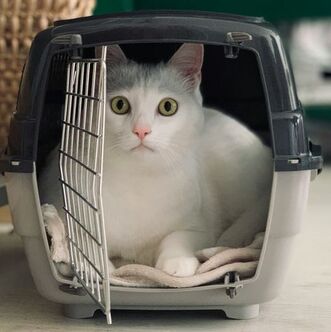 Photo by Anatolii Kozhukhar on Unsplash Photo by Anatolii Kozhukhar on Unsplash Many dogs and cats experience fear, anxiety, and stress at the veterinary clinic. Their anxiety often begins before they even arrive at the clinic, especially if they associate pet carriers and car rides with the clinic. Previsit antianxiety medications for pets can make clinic visits easier and safer for these pets, their owners, and clinic staff. These are some of the benefits of previsit medications for anxious pets:
Previsit medications have benefits for pet owners and clinic staff members too. Being the caretaker of an anxious and fearful pet isn’t easy, so previsit medications for pets can reduce everyone’s stress levels. For clinic staff members, managing patients’ clinic anxiety reduces the risk of injury and decreases workplace stress (we love animals too and don’t want to cause them distress). How to Know if Your Pet Needs Previsit Medications Previsit medications aren’t just for aggressive animals. Pets with more subtle signs of stress are scared too, and they deserve help for their anxiety just as much as animals that can’t be handled without full sedation. If your pet shows obvious signs of fear at the clinic, you probably already know that your pet would benefit from previsit medications. But maybe your pet’s signs are not as noticeable and you’re a little surprised when your veterinarian recommends medications. Dogs and cats show anxiety and fear with a range of behaviors and body language cues. Anxious and fearful dogs and cats tend to start with subtle behaviors like lip licking or freezing. If the scary thing doesn’t go away—or tries to draw a blood sample—the behavior can escalate to aggression. Dogs and cats that are anxious at the veterinary clinic can show these signs:
How to Use Previsit Medications Previsit medications work best if they’re used along with training and positive reinforcement. For example, a cat can make positive associations with the cat carrier if the carrier is left out all the time as part of the normal household furniture, sometimes with yummy treats inside, instead of appearing only when the cat is going to the clinic. Veterinarians choose previsit medications according to the needs and medical condition of the individual patient. Some of the drugs commonly prescribed for situational (short-term) anxiety are gabapentin, trazodone, and clonidine. Motion sickness contributes to anxiety, so pets might also receive antinausea medication. Some of these medications can cause sedation, but the main goal is anxiety reduction, not sedation. Previsit medications are timed to have maximum effect at the time of the clinic visit. They need to take effect before the pet experiences any stress. Most of these medications are given at least 1 to 2 hours before the clinic visit; sometimes a loading dose is also given the night before. They typically last for up to 8 hours, although the duration can vary. Because individual animals respond differently to these medications, giving a trial dose can be very helpful. If you use a trial dose, tell your veterinarian how long it took for the medication to take effect, how the medication affected your pet’s behavior, whether your pet had adverse effects like vomiting or excessive sedation, and how long the medication’s effects lasted. For some dogs and cats, previsit medications aren’t enough to overcome their fear. These pets might also need a sedative injection at the clinic. For these pets, previsit medications given at home make the sedative injection easier for the pet (and staff) and can also reduce the dose of injectable drug. Image source: https://unsplash.com/photos/a-white-cat-sitting-inside-of-a-cage-B-_SyRxv2So Laurie Anne Walden, DVM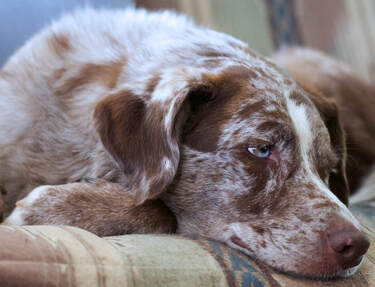 Public domain photo by Alan Levine on flickr Public domain photo by Alan Levine on flickr Palliative care and end-of-life hospice care for animals focus on improving quality of life, not curing disease. The decision to begin these types of care can be difficult for pet owners. Whether palliative care is right for an individual pet depends on the needs and capacity of the family as well as the medical needs of the animal, so the decision is specific to each pet and each caregiver. Animals that are candidates for palliative and hospice care typically fall into one of these categories:
Palliative care is treatment that minimizes an animal’s pain and distress (without curing disease) at any time, not just at the end of life. The term hospice care more specifically refers to care near the end of life. Hospice care generally includes palliative care for the animal and support for the human caregivers. The biggest difference between human and animal hospice care is that euthanasia is a legal and humane option for animals. Hospice-assisted natural death is possible for some animals. However, choosing to let pets “die on their own” without any relief of pain and distress is unethical. Some veterinarians are specialists in palliative and hospice care. End-of-life care for animals might involve a team including veterinary staff members, specialists (like grief counselors) to support the humans, and the pet owners themselves. Tips for Pet Owners The American Association of Feline Practitioners recently published hospice and palliative care guidelines for cats and has very helpful suggestions for pet owners (not just cat owners). Here’s a summary; for more details, see the Cat Friendly Homes website.
If you know your pet is nearing the end of life, it can be very helpful to plan in advance for your pet’s death. Options might include euthanasia at your veterinarian’s office, home euthanasia (if available in your location), or hospice-assisted natural death (if appropriate and available for your pet). Ask about the euthanasia procedure and the cremation and burial options. For More Information
Image source: https://www.flickr.com/photos/cogdog/25256183337/ Laurie Anne Walden, DVM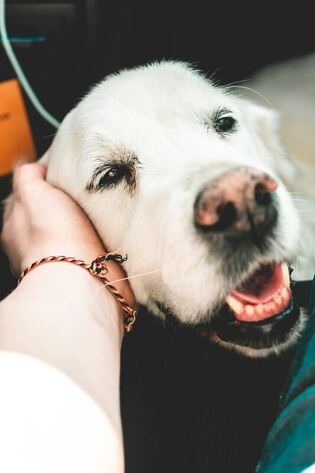 Photo by Alexandre Debiève on Unsplash Photo by Alexandre Debiève on Unsplash Most dogs and cats cope very well with vision loss. They rely more on the sense of smell than on the sense of sight. Blind animals can have happy, comfortable lives with some help from their owners. Pets with gradual vision loss often adapt so well that their owners don’t realize their pets are having trouble seeing until they’re completely blind and bumping into things. Animals with sudden blindness can take longer to adjust. Safety and Navigation Use gates and other barriers to block a blind animal’s access to stairs, swimming pools, fireplaces, and other dangers. Use foam cushioning (child safety equipment) to pad furniture corners. Keep the floor clear of trip hazards like toys and laundry. Keep blind animals in a crate or other secure space whenever they’re unsupervised, at least while they’re adjusting to their loss of vision. This space can also become a safe, familiar retreat. Blind animals can have a hard time navigating stairs, especially descending. Be patient and use a harness and treats to show blind dogs how to manage stairs. Consider covering short runs of steps with a ramp. Nonslip strips applied to stair treads might make a blind pet feel more secure. Dogs and cats that sleep on furniture might need a ramp or steps so they don’t have to jump up and down. To help blind pets learn their way around the house, don’t pick them up and carry them; let them walk on their own. Different floor surfaces (mats or rugs) can help them identify specific areas like doorways and the location of food and water bowls. A radio left on at all times in one room and scents applied to furniture at the pet’s head height can also help orient them inside the house. Face whiskers help animals feel obstacles, so don’t have their whiskers trimmed at grooming appointments. Vests with circular extensions around the head or chest (halo vests) are available for blind dogs who keep bumping into things. Exercise and Mental Health Blind animals need exercise just like every other animal, but they shouldn’t go outdoors unsupervised. Even a small fenced yard can have holes and fallen branches that would pose a risk to a blind pet. If you don’t have a fenced yard that’s safe and familiar to your dog, keep your dog on a leash. When walking your blind dog, attach the leash to a harness instead of a collar in case you need to pull your dog away from a hazard. Teach your dog verbal cues like “left,” “right,” and “stop.” An unexpected touch can frighten a blind dog, so warn people who approach that your dog is blind. Consider using a dog vest with the words “Blind dog” or “Do not pet.” Be very careful if another dog approaches while you’re walking your dog. A blind dog can’t read other dogs’ body language. If you let your dog interact with another dog, be sure that the other dog is friendly and that your dog is comfortable with the interaction. Provide toys that stimulate senses other than sight. Use toys with bells (with supervision—bells can be a choking hazard), catnip toys for cats, and tracking games for dogs who enjoy following scents. For some animals, playing contact games like tug of war might be easier than chasing toys by sound or scent. Some animals experience anxiety while they’re adjusting to vision loss. Keep your pet’s routine consistent, stay positive around your pet, and provide a safe retreat like a crate. Behavior changes like hiding, reluctance to walk or play, growling, barking, and snapping can all be signs of anxiety. Contact your veterinarian if your pet has any of these changes or seems to be having trouble adapting. Some pets benefit from short-term or long-term prescription anxiety medications. For more ideas, see the ACVO Vision for Animals Foundation website: https://www.visionforanimals.org/coping-with-a-blind-dog/ Image source: https://unsplash.com/photos/SEX4KAz9ExQ Laurie Anne Walden, DVM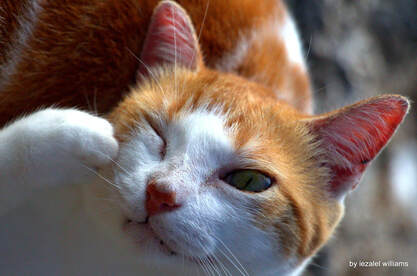 Photo by iezalel williams on Flickr Photo by iezalel williams on Flickr Many dogs and cats need eye medication at some point in their lives. Pets with chronic eye diseases might need more than 1 eye medication given multiple times a day for years. With practice and positive reinforcement, giving eye medication to an animal can be quick and drama free. If your pet doesn’t need eye medication yet, you can train them for it in advance. This training will reduce your pet’s stress when they need medication later on. Go through the body positioning and head handling steps listed below and give yummy treats at each stage. Large dogs can be trained to rest their head on your knee to receive eye medication. Handling Eye Medication
Giving Multiple Medications
Preparation
Administering the Medication
Watch for Unwanted Effects Some eye medications are a little uncomfortable for the first few applications. It’s common for animals to blink more than usual or squint for a minute or two after an eye medication is applied. If your pet’s eye seems uncomfortable for more than a few minutes or if this response continues for more than the first few doses, contact your veterinarian. Image source: https://www.flickr.com/photos/181765699@N08/48298582227/ Laurie Anne Walden, DVM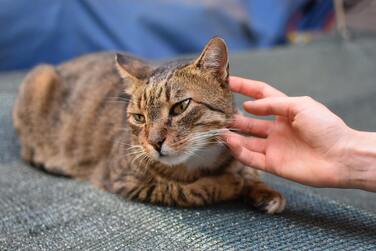 Photo by Ilze on Unsplash Photo by Ilze on Unsplash Aggression related to being petted is very common in cats. Cats with this type of aggression suddenly scratch, growl, or bite while they’re being petted. The most likely explanations for petting-related aggression are that the cat is overstimulated, has a low tolerance for being touched, or is trying to exert some control over the interaction. It’s also possible that the cat has a medical problem (for example, pain caused by arthritis or dental disease). Any type of aggression, especially if it’s a new behavior, warrants an examination by a veterinarian. The people most at risk of injury are children and others who don’t know the signs that a cat is uncomfortable with an interaction. Tolerance to petting varies from cat to cat, and the same cat’s tolerance can change according to the circumstances. To help people understand the best way to interact with cats, a team of researchers in the United Kingdom developed a set of guidelines that they describe with the acronym CAT (for choice, attention, and touch).[1] The team found that cats showed less aggression when people followed the CAT guidelines during interactions. The gist of the CAT guidelines is that we should handle cats the way they want to be handled and leave them alone when they want to be left alone. Makes sense, right? However, in another study, the same team found that some people who had lots of cat-owning experience and rated their own cat knowledge as high interacted in ways the cats did not want.[2] The following is a summary of the CAT guidelines, or how to pet a cat. C: Give the cat choice and control.
A: Pay attention to the cat’s body language. These are signs that a cat might not want to be petted any longer:
T: Touch the cat only where the cat wants to be touched.
To read more about cat-friendly petting and how humans interact with cats, check out these 2 articles:
References 1. Haywood C, Ripari L, Puzzo J, Foreman-Worsley R, Finka LR. Providing humans with practical, best practice handling guidelines during human-cat interactions increases cats' affiliative behaviour and reduces aggression and signs of conflict. Front Vet Sci. 2021;8:714143. doi:10.3389/fvets.2021.714143 2. Finka LR, Ripari L, Quinlan L, et al. Investigation of humans individual differences as predictors of their animal interaction styles, focused on the domestic cat. Sci Rep. 2022;12(1):12128. doi:10.1038/s41598-022-15194-7 Photo by Ilze on Unsplash Laurie Anne Walden, DVM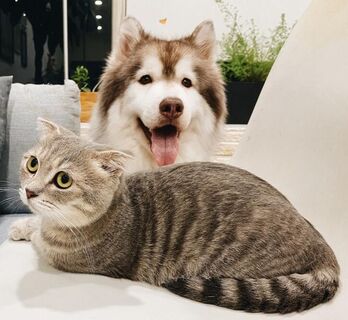 Photo by Tran Mau Tri Tam Photo by Tran Mau Tri Tam Urinalysis is part of the diagnostic workup for many medical conditions, such as kidney disease, diabetes, and urinary tract infection. Pets that are urinating in unfortunate locations need urinalysis because inappropriate urination can be a symptom of a medical problem. Routine wellness checks, especially for senior animals, often include urinalysis. Urine is also collected for bacterial culture and other tests. Urinalysis includes measurement of urine concentration, chemical analysis, and examination under a microscope. The results are affected by the age of the urine and the way the sample is collected. Urine begins to change soon after it’s voided, so urine samples need to be very fresh, ideally delivered to the veterinary clinic within an hour. The collection container needs to be completely clean, with no residue from food or cleaning solutions that can affect the chemical test results. Debris in a urine sample interferes with the chemical analysis and microscopic examination. Urine can be collected either at home or at the veterinary clinic, depending on the reason the sample is needed and individual pet and household factors (such as the animal’s temperament and medical conditions, owner’s ability to collect urine, and distance to the clinic). Home urine collection is fine for most routine urinalysis, but check with your veterinarian to be sure it’s appropriate for your pet. Sometimes urine needs to be collected in a sterile manner at the veterinary clinic. In these cases, urine is usually collected by cystocentesis, a technique using a needle inserted directly into the bladder. General Urine Collection Tips
Collecting Urine From Dogs
Collecting Urine From Cats
Photo by Tran Mau Tri Tam on Unsplash Laurie Anne Walden, DVM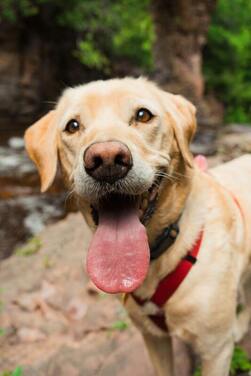 Photo by Lucas Ludwig Photo by Lucas Ludwig Pets need stool tests to screen for parasites or help find the cause of diarrhea and other digestive system problems. Collecting a stool sample at home is the least stressful option for the pet. The alternative is for someone at the veterinary clinic to use a loop to remove a little bit of stool from the rectum. This option yields a much smaller sample and can be unpleasant for the animal. A fecal test for parasites involves mixing the stool sample in a flotation solution and either spinning it in a centrifuge or leaving it to sit in a vial for a certain amount of time. The material at the top of the solution is then removed to a microscope slide to look for parasite eggs that have floated to the surface. Sometimes a tiny bit of stool is smeared directly onto a microscope slide for examination. Fecal analysis can also include chemical tests. For all of these tests, the stool needs to be fresh and squishy enough to mix or smear. The age and condition of a stool sample affect the results. Parasite eggs can dry out or hatch in old stool. Hard, dry feces is very difficult or impossible to prepare for testing. Stool that has been sitting outdoors for a while can contain fly eggs or larvae (maggots). Liquid diarrhea that’s soaked into paper or cloth can’t be mixed in solution to test for parasites. Here’s how to collect a stool sample to get the most accurate results:
Photo by Lucas Ludwig on Unsplash Laurie Anne Walden, DVM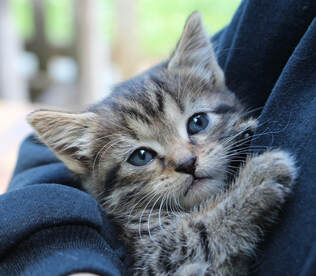 Photo by Haley Owens Photo by Haley Owens Socializing young kittens and puppies means giving them positive experiences with things they’ll encounter throughout their lives. Building positive associations early in life helps animals feel comfortable with new people and new situations. Animals that are well socialized when they’re young are less likely to develop fear-based behavior problems (like aggression) that could put them at risk of being sent to a shelter or euthanized later on. Sensitive Period for Socialization For kittens, the window of opportunity for socialization is very early: from 3 weeks to about 7 to 9 weeks of age.[1,2] The sensitive period is the time when a young kitten’s brain is most receptive to socialization. During these early weeks, a kitten is exploring and learning, developing neurological pathways that will help the kitten learn in the future. After the sensitive period, brain development shifts; kittens don’t make positive associations as quickly or easily and they’re more likely to be afraid of new things. This is why it’s so difficult, if not impossible, to convert a semi-feral adult cat into a cat that can be happy living as a house pet. You will have noticed that the sensitive socialization period for kittens is nearly closed by the time they’re typically adopted or purchased. Socialization needs to start with the person caring for the mother cat and newborns. When you adopt or buy a kitten, continue providing socialization (at the kitten’s comfort level and pace) to reinforce what the kitten has already learned. The socialization process should always be positive. Don’t force kittens to interact with strangers or other animals if they’re shy, and don’t push them to be near things that scare them. Let them choose whether to interact. Give them room to walk away and let them hide if they want to. Use positive reinforcement (food or play) to encourage them to interact and build their confidence. The following suggestions are adapted from the American Veterinary Medical Association.[1] For more tips, check out the First Year of Life page on the Cat Friendly Homes website: https://catfriendly.com/life-stages/first-year-life/ Socializing Kittens Before Weaning
Socializing Kittens 8 to 12 Weeks Old
Older Kittens and Newly Adopted Adult Cats
References 1. Welfare implications of socialization of puppies and kittens. American Veterinary Medical Association. June 9, 2015. Accessed July 8, 2022. https://www.avma.org/resources-tools/literature-reviews/welfare-implications-socialization-puppies-and-kittens 2. Todd Z. The sensitive period for socialization in puppies and kittens. Companion Animal Psychology. July 26, 2017. Accessed July 8, 2022. https://www.companionanimalpsychology.com/2017/07/the-sensitive-period-for-socialization.html Photo by Haley Owens on Unsplash |
AuthorLaurie Anne Walden, DVM Categories
All
Archives
June 2024
The contents of this blog are for information only and should not substitute for advice from a veterinarian who has examined the animal. All blog content is copyrighted by Mallard Creek Animal Hospital and may not be copied, reproduced, transmitted, or distributed without permission.
|
- Home
- About
- Our Services
- Our Team
-
Client Education Center
- AKC: Spaying and Neutering your Puppy
- Animal Poison Control
- ASPCA Poisonous Plants
- AVMA: Spaying and Neutering your pet
- Biting Puppies
- Boarding Your Dog
- Caring for the Senior Cat
- Cats and Claws
- FDA warning - Bone treats
- Force Free Alliance of Charlotte Trainers
- Getting your Cat to the Vet - AAFP
- Holiday Hazards
- How To Feed Cats for Good Health
- How to Get the Most Out of your Annual Exam
- Indoor Cat Initiative - OSU
- Introducing Your Dog to Your Baby
- Moving Your Cat to a New Home
- Muzzle Training
- Osteoarthritis Checklist for Cats
- What To Do When You Find a Stray
- Our Online Store
- Dr. Walden's Blog
- Client Center
- Contact
- Cat Enrichment Month 2024
|
Office Hours
Monday through Friday 7:30 am to 6:00 pm
|
Mallard Creek Animal Hospital
2110 Ben Craig Dr. Suite 100
|
Site powered by Weebly. Managed by IDEXX Laboratories

 RSS Feed
RSS Feed